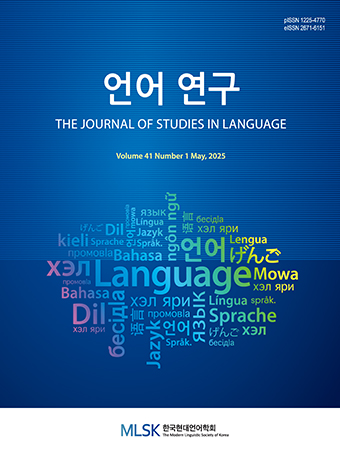Research Article
Abstract
References
Information
I claim that the result phrase in Korean resultative construction is an adjunct à la Shim and den Dikken (2007). At the same time, diverging from them, I argue that the result phrase in Korean transitive resultative construction projects a finite CP, whereas the one in the intransitive resultative construction projects a nonfinite CP, based on important differences between the two resultative constructions. The present proposal can address various properties of Korean resultative construction in their entirety, including case on the antecedent NP, iteration of the result phrase, and obviation of the direct object restriction (Levin and Rappaport, 1995) as distinct from English resultative construction. The present research has an important implication on the cross-linguistic variation in the syntactic representation of the result phrase: adjunct in Korean and complement in English (Carrier and Randall, 1992; Hoekstra, 1988; Kayne, 1985; Voorst, 1986).
- Carrier, J. and Randall, J. 1992. The Argument Structure and Syntactic Structure of Resultatives. Linguistic Inquiry 23.2, 173-234.
- Choi, Y.-S. 2019. Adjectives in Korean are NOT. The Linguistic Association of Korea Journal 27.1, 122-141. 10.24303/lakdoi.2019.27.1.122
- Chomsky, N. 1981. Lectures on Government and Binding. Dordrecht: Foris.
- Chomsky, N. 1986. Barriers. Cambridge, Mass.: MIT Press.
- Chomsky, N. 1995. The Minimalist Program. Cambridge, Mass.: MIT Press.
- Dowty, D. 1978. Governed Transformations as Lexical Rules in a Montague Grammar. Linguistic Inquiry 9.3, 393-426.
- Folli, R. 2001. Deriving Telicity in English and Italian. Doctoral dissertation, Oxford University, Oxford.
- Hamann, C. 1991. Adjectives. In A. von Stechow & D. Wunderlich (eds.), Semantik: Ein Internationales Handbuch der Zeitgenossischen Forschung. Berlin: Walter de Gruyter, 657-673. 10.1515/9783110126969.8.657
- Higginbotham, J. 2009. Tense, Aspect, Indexicality. Oxford and New York: Oxford University Press. 10.1093/acprof:oso/9780199239313.001.0001
- Hoekstra, T. 1988. Small Clause Results. Lingua 74, 101-139. 10.1016/0024-3841(88)90056-3
- Hong, S. 2002. Raising to Object in Small Clauses. Studies in Modern Grammar 30, 89-108.
- Hong, K.-S. 2011. English Resultative Construction and Korean key Construction. Korean Journal of Linguistics 36.4, 1143-1169. 10.18855/lisoko.2011.36.4.014
- Kang, E.-Y. 2001. The key Constructions in Korean Predicate: Head or a Complementizer. Harvard studies in Korean linguistics 9, 433-442.
- Kayne, R. 1985. Principles of Particle Constructions. In J. Gueron, H. Obenauer, and J.-Y. Pollock. (eds.), Grammatical Representation. Dordrecht: Foris, 101-140. 10.1515/9783112328064-006
- Kim, J.-B. 1999. Constraints on the Formation of Korean and English Resultative Constructions. Proceedings of the North East Linguistic Society 29, 137-151.
- Kim, M.-J. 2002. Does Korean Have Adjectives? MIT Working Papers in Linguistics 43, 71-89.
- Kim, S. and Maling, J. 1997. A Cross-linguistic Perspective on Resultative Formation. In B, Ralph, and M. Moosally (eds.), Texas Linguistic Forum 38, University of Texas Department of Linguistics, Austin, Texas, 189-204.
- Kim, S. and Maling, J. 1998. Resultatives: English vs. Korean. Journal of Korean Linguistics 7, 363-379.
- Kim, S., Ko, H., and Yang. H.-K. 2020. Telicity and Mode of Merge in L2 Acquisition of Resultatives. Language Acquisition 27.2, 117-159. 10.1080/10489223.2019.1659275
- Ko, H. 2015. On the Typology of Small Clauses: Null Subject and Mode of Merge in Resultatives. Studies in Generative Grammar 25.2, 347-375. 10.15860/sigg.25.2.201505.347
- Kratzer, A. 2005. Building Resultatives. In C. Maienborn and A. Wöllstein (eds.), Event Arguments: Foundations and Applications, Tübingen: Max Niemeyer Verlag, 177-212. 10.1515/9783110913798.177
- Levin, B. and Rappaport, M. 1995. Unaccusativity: At the Syntax-lexical Semantics Interface. Cambridge, MA.: The MIT Press.
- Rothstein, S. 1983. The Syntactic Forms of Predication. Doctoral dissertation, MIT, Cambridge, Massachusetts.
- Schein, B. 1982. Small Clauses and Predication. Unpublished manuscript, MIT.
- Shim, J. and den Dikken, M. 2007. The Tense of Resultatives: The Case of Korean. Proceedings of the North East Linguistic Society 38, 337-350.
- Simpson, J. 1983. Resultatives. In B. Levin, M. Rappaport Hovav, and A. Zaenen (eds.), Papers in Lexical-Functional Grammar, Bloomington: Indiana University Linguistics Club, 143-157.
- Sohn, H.-M. 1996. Korean Grammar. Cambridge, MA: Cambridge University Press.
- Sohn, H.-M. 1999. The Korean Language. London and New York: Routledge.
- Son, M. 2008. Resultatives in Korean Revisited: Complementation versus Adjunction. Tromsø Working Papers on Language and Linguistics 35.1, 89-113. 10.7557/12.138
- Song, H. 2005. Causatives and Resultatives in Korean. Doctoral dissertation, University of Wisconsin-Madison.
- Vendler, Z. 1957. Verbs and Times. Philosophical Review 66.2, 143-160. 10.2307/2182371
- Voorst, J. 1986. Event Structure. Doctoral dissertation, University of Ottawa, Ontario.
- Wechsler, S. and Noh, B. 2001. On Resultative Predicates and Clauses: Parallels between Korean and English. Language Sciences 23.4-5, 391-423. 10.1016/S0388-0001(00)00031-0
- Publisher :The Modern Linguistic Society of Korea
- Publisher(Ko) :한국현대언어학회
- Journal Title :The Journal of Studies in Language
- Journal Title(Ko) :언어연구
- Volume : 38
- No :2
- Pages :169-187
- DOI :https://doi.org/10.18627/jslg.38.2.202208.169




 The Journal of Studies in Language
The Journal of Studies in Language






